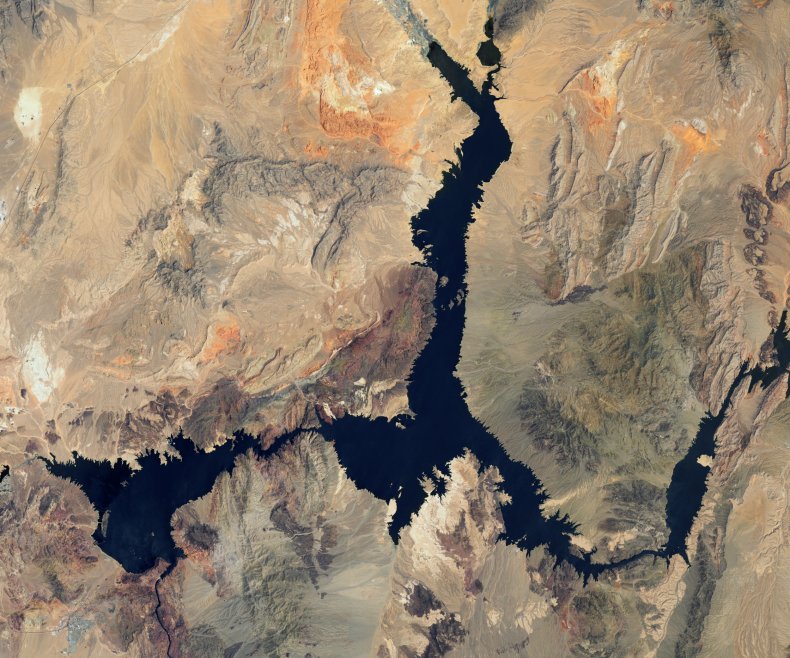NASA pictures of Lake Mead taken from space show the dramatic drop in water levels since 2000.
The photographs, taken by geographical monitoring satellites Landsat 7 and Landsat 8, show how far the shoreline of Lake Mead has crept inwards over the past two decades, with large portions of the lake's northern section having completely dried up.
"Bathtub rings" around the current shore are also visible, which are light-colored mineralized shore areas where the lake water has now evaporated away.



Lake Mead is a reservoir of the Colorado River formed by the Hoover Dam, spanning the states of Arizona and Nevada. This huge lake sees water levels that are currently at their lowest point for 85 years, since April 1937.
Since 2000, the lake has continuously broken its own lowest water records nearly every year, steadily decreasing until now. As of July 18, Lake Mead was filled to just 27 percent of its full water capacity, and the Colorado River as a whole, which provides approximately 97 percent of Lake Mead's inflow, was only at 35 percent capacity.
At full capacity, Lake Mead would be the largest reservoir in the U.S. It supplies drinking water and agricultural irrigation to seven states, including Arizona, California, and Nevada, as well as parts of Mexico, providing for 20 million people.
This enormous drop in water levels is thought to be a result of the megadrought gripping most of the U.S. Southwest, which, exacerbated by the effects of climate change, may be the worst drought for over 1,200 years. According to the U.S. Drought Monitor, Clark County in Nevada and Mohave County in Arizona, where Lake Mead is situated, are both currently experiencing "exceptional drought." Evaporation of the lake's water due to the extreme heat and low humidity in the area represents a significant portion of the water loss.
Wow! Lake Mead July 6th 2000 through July 3rd 2022. Photo by @NASA @NASAEarth @News3LV #Vegas #vegasweather #drought pic.twitter.com/9mOI0LEuQU
— Bill Bellis (@BillBellis) July 21, 2022
With the current climate trends, the drought conditions in areas like the U.S. West are only expected to get worse, with heatwaves becoming more extreme and rainfall decreasing thanks to the effects of climate change.
A consequence of Lake Mead's water level falling so drastically is that it cannot provide water to all the places it previously could.
In June 2022, the U.S. Bureau of Reclamation issued an emergency request, urging states relying on the Colorado River basin to reduce their water usage by between 2 million and 4 million acre-feet over the next year and a half.
Additionally, the Hoover Dam generates electricity via hydroelectric energy harvested from the water moving out of the reservoir via turbines. The lower the water levels in Lake Mead, the less electricity generated by the dam. In anticipation of this, the dam was fitted with turbines that would work better with a lower lake level, giving the lake a leeway of around 100 extra feet of water level drop.
However, if water levels continue to drop below 950 feet, the dam would cease to generate power.

Thanks to the reduced water levels, five of a total of six boating ramps have had to be closed, according to the National Park Service. Lake Mead is a popular recreation spot, and the loss of the tourism will further cost the local economy.
"Declining water levels due to climate change and 20 years of ongoing drought have reshaped the park's shorelines," the Park Service said on its website. "As Lake Mead continues to recede, extending launch ramps becomes more difficult and more expensive due to the topography and projected decline in water levels."
Uncommon Knowledge
Newsweek is committed to challenging conventional wisdom and finding connections in the search for common ground.
Newsweek is committed to challenging conventional wisdom and finding connections in the search for common ground.
About the writer
Jess Thomson is a Newsweek Science Reporter based in London UK. Her focus is reporting on science, technology and healthcare. ... Read more





